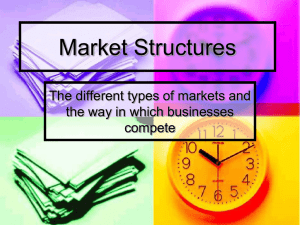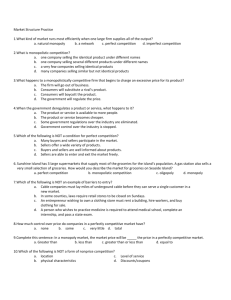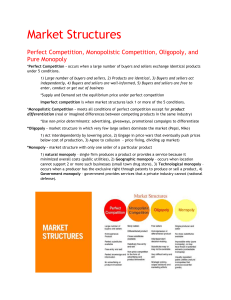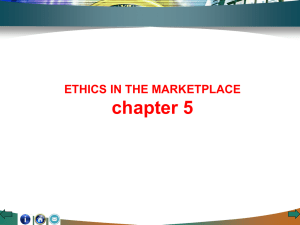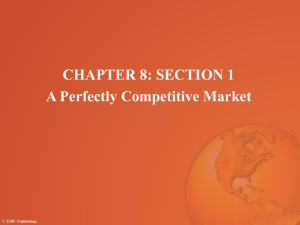Bell Ringer - Ms. Edlund's Social Studies Classes
advertisement
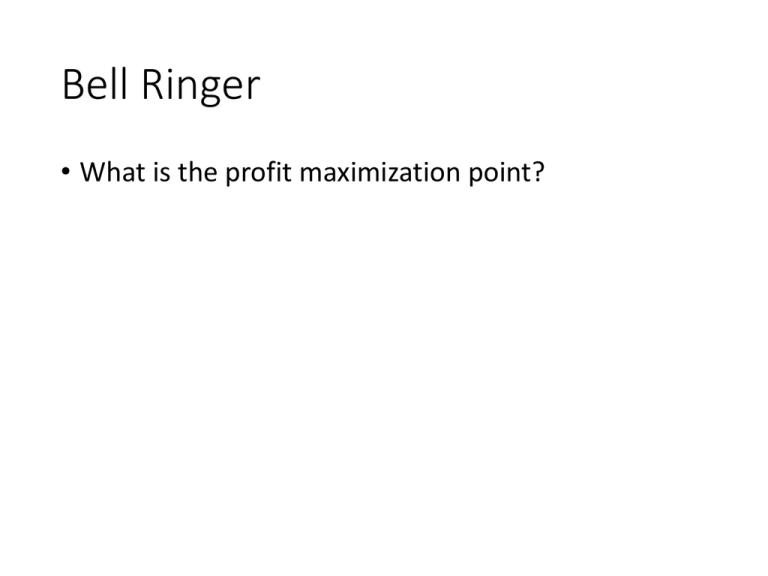
Bell Ringer • What is the profit maximization point? Andrea’s Software Business 120 100 P r i c e Profit Maximization Point MR = MC 80 MC Profit = ($56-$48.125) x 8 = $63 P 60 MR Profit = (P-ATC) x QPROFIT ATC 40 Total Revenue =PxQ TOTAL COST 20 TR = $56 x 8 = $448 0 1 2 3 4 5 Quantity 6 7 8 9 10 Market Structure • The setting in which a seller finds itself. • Market Structures are defined by the following characteristics: • Number of sellers in the market • The product that sellers produce and sell • How easy or difficult it is for new firms to enter the market Market Structure • 4 types of Market Structure • • • • Perfectly Competitive Monopolistic Monopolistic Competitive Oligopolistic Perfectly Competitive Market • A market structure characterized by: 1. Many buyers and sellers 2. All firms selling identical goods 3. All relevant information about buying and selling activities available to buyers and sellers 4. Easy entry into and easy exit out of the market • Sellers in a PC market are PRICE TAKERS • Price taker – a seller that can sell all its output at the equilibrium price but can sell none of its output at any other price Costs and Competitive Market Supply • A look at Fiasco Company. Bell Ringer • What are the characteristics of a perfectly competitive market? Fiasco Company Fiasco Company Fiasco’s Cost Curves Market Supply and Demand Firms Making a Profit Firms Experiencing a Loss Long-Run Equilibrium Bell Ringer • Sketch a firm, in a Perfectly Competitive Market, that is operating at the long-run equilibrium. Profit as a Signal Loss as a Signal Two Resource Markets Perfect Competition v. Monopoly Perfectly Competitive Market 1. Many buyers and sellers 2. All firms selling identical goods 3. Easy entry into and easy exit out of the market • Price taker – a seller that can sell all its output at the equilibrium price but can sell none of its output at any other price Monopolistic Market 1. One seller 2. A good with no close substitutes 3. High barriers to enter and exit the market Two Resource Markets Perfect Competition v. Monopoly Perfectly Competitive Market 1. Many buyers and sellers 2. All firms selling identical goods 3. Easy entry into and easy exit out of the market • Price taker – a seller that can sell all its output at the equilibrium price but can sell none of its output at any other price Monopolistic Market 1. One seller 2. A good with no close substitutes 3. High barriers to enter and exit the market • Price Searcher – a seller that can sell some of its output at various prices Perfect Competition v Monopoly Perfect Competition v. Monopoly • Classify the following product markets as being more like a Perfect Competition market or more like a Monopolistic Market: • • • • • • Wheat Cellphone service Haircuts Airline flights Restaurant Hamburgers Soft Drinks Bell Ringer • What is a “price searcher”? Barriers to Entry – Imperfect Markets • Legal Barriers • Patents, copyrights, public franchise • Public franchise is a right granted to a firm by government that permits the firm to provide a good or service and excludes all others fromMONOPOLIES doing so. GOVERNMENT • US Postal Service on 1st Class Mail • Cable Companies • Trash Collectors • Low Per Unit Cost (Low ATC) • Natural Monopoly MARKET MONOPOLIES • A firm with such a low ATC that it is the only one that can survive in the market • Exclusive Ownership of a Resource Jack and Jill’s Oligopoly Game Jack’s High Production: 40 Gal. Jack gets $1,600 profit Decision Low Production: 30 gal. Jack gets $1,500 profit High Cartel Agreement Production Jill’s Decision 40 gal. An agreement that specifies how the firms that profit Jill gets profit entered into the$1,600 agreement will actJillingets a $2,000 coordinated $2,000 profit among them Jack gets $1,800 profit way to reduce Jack thegets competition Low Production 30 gal. Jill gets $1,500 profit Jill gets $1,800 profit Price Discrimination • When a seller charges different prices to different buyers and the price differences do not reflect cost differences. • Conditions that must exist: 1. Different customers must be willing and able to pay different prices 2. The seller must be able to tell who is willing to pay the different prices 3. It has to be impossible or extremely difficult for a customer to resell the good Price Discrimination • Why price discriminate? • A firm can increase its Total Revenue • Can be illegal if: • It reduces competition within a market • A firm charges different prices in different states without a difference in costs Demand Schedule for Widgets Price $10 Quantity 1 $8 $6 2 3 Bell Ringer • What are ways that firms in Monopolistic Competitive and Oligopolistic markets behave to try to be more like Monopolies? Advertising • Used by firms to persuade buyers that its product is more than slightly differentiated from those of its competitors. • Found mainly in monopolistic competitive markets • Highlight the differences between similar products • Brand names • Designer labels Government Regulation • Government wants to maintain competition because it is in the best interests of the consumers • Antitrust laws – legislation passed for the stated purpose of controlling monopoly power and preserving and promoting competition. Government Regulation • Major Regulation Legislation (p. 199 – 201) • • • • • Sherman Antitrust Act of 1890 Clayton Act of 1914 Federal Trade Commission Act of 1914 Robinson-Patman Act of 1936 Wheeler-Lea Act of 1938 • Goal of the legislation • Behaviors the legislation prohibits or limits Antitrust Laws • The Sherman Antitrust Law (1890) • Forming a trust (monopoly) is illegal • The Clayton Act (1914) • Certain businesses practices were made illegal if they lessen competition • Price discrimination – when a seller charges different prices to different buyers of the same product • Tying contracts – sale of one good depends on the sale of another good • The Federal Trade Commission Act (1914) • Created the FTC • Made “unfair methods of competition in commerce” are illegal • The Robinson-Patman Act (1936) • Prohibits suppliers from offering special discounts to large chains unless they offered them to everyone • The Wheeler-Lea Act (1938) • Empowered the FTC to deal with false and deceptive practices by businesses




